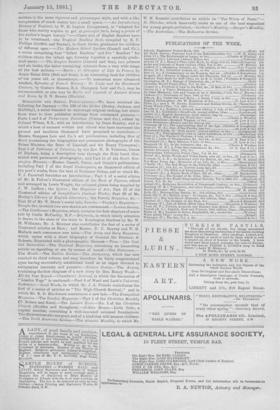MAGAZINES AND SERIAL PUBLICATIONS.—WO have received the following for January
:—No. 133 of the Etcher (Seeley, Jackson, and Halliday), a serial founded to encourage original etching, but which from time to time publishes etchings from celebrated pictures.— Parts 1 and 2 of Picturesque Palestine (Virtue and Co.), edited by Colonel Wilson, R.E., with an introduction by Doan Stanley, and to which a boot of eminent writers and others who have traversed the ground and localities illustrated have promised to contribute.— Messrs. Sampson Low and Co.'s art publications, including Men of Mark (containing the biographies and permanent photographs of the Primo Minister, the Dean of Llandaff, and Sir Henry Thompson) ; Part 1 of Pathways of Palestine, by the Rev. H. B. Tristram, Canon of Durham, being a descriptive tour through the Holy Land, illus- trated with permanent photographs ; and Part 11 of the South. Ken- sington Museum.—Messrs. Cassell, Potter, and Galpin's publications, including Part 1 of the Royal Shakespeare, an illustrated edition of the poet's works, from the text of Professor Delius, and to which Mr. F. J. Furnivall furnishes an introduction ; Part 1 of a serial edition IA Mr. R. Fulton's illustrated edition of the Book of Pigeons, edited and arranged by Lewis Wright, the coloured plates being supplied by J. W. Ludlow ; the Quiver ; the Magazine of Art; Part 19 of the illustrated edition of Longfellow's Poetical Works ; Part 69 of Mr. Morley's Library of English Literature ; the Family Magazine, &c.— Part 10 of Mr. W. Black's serial tale, Sunrise.—Tinsley's Magazine.— Temple Bar, in which two new stories are commenced.—London Society. —The Gentleman' s Magazine, which contains the first chapters of anew tale by Justin McCarthy, M.P.—Belgravia, in which timely attention is drawn to the state of the trees in Kensington Gardens by Mr. W. M. Williams ; Mr. A. Rimmer also contributes the first of a series of illustrated articles on Eton ; and Messrs. D. C. Murray and W. H. Mallook each commence new tales.—The Army and Navy Magazine, which opens with a short biography of General Sir Frederic S. Roberts, illustrated with a photographic likeness.—Time.—Tho Scot- tish Naturalist. —The Nautical Magazine, containing an interesting article on signalling at sea by means of sound.—The Statesman.— The Month.—The Dublin Review.—The Antiquary, which has now reached its third volume, and may therefore be fairly congratulated upon having successfully established itself as an organ devoted to antiquarian interests and pursuits.—Science Gossip.--The Argosy, Containing the first chapters of a new story by Mrs. Henry Wood.— All the Year Round.—Chanzbers's Journal, in which the discussion of " London Fogs " is oontinued.—Part 3 of Ward and Lock's Universal Instructor.—Good Words, to which Mr. J. A. Fronde contributes the first of a series of articles on "The High-Church Revival ;" and in which Mr. R. D. Bla3krnore commences a now tale.—The Evangelical Magazine.—The Sunday Magazine.—Part 1 of the Christian Monthly (T. Nelson and Sons).—The Leisure Hour.—No. 1 of the Christian Church (Hodder and Stoughton).—Golden Hours.—Little Folks, a capital number, containing a well executed coloured frontispiece. The illustrations also are good, and of a kind that will interest children. —The North American Review.—The Atlantic Monthly, to which Mr. W. M. Rossetti contributes an article on " The Wives of Poets."--- St. Nicholas, which deservedly ranks as one of the best magazines for young people published.—Scribner's Monthly.—liarper's Monthly. —The Australian.—The Melbourne Review.


































 Previous page
Previous page